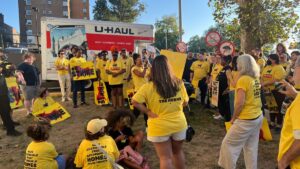This story was originally published by Stateline.
Some cities and states are trying to boost Black homeownership, which dropped to a 60-year low even before the economic turmoil wrought by the COVID-19 pandemic.
Black homeownership fell in 2019 to 40.6%, down from the 2004 peak of 49.7%. The rate has rebounded somewhat since then, but advocates remain dismayed at how, decades after the 1968 Fair Housing Act, Black families still struggle to become homeowners at the same rate as White peers.
“To see the Black homeownership rate lower than the generation before is shocking, considering what earlier generations faced,” said Janneke Ratcliffe, vice president of the Housing Finance Policy Center at the Urban Institute in Washington, D.C.
The persistence of redlining, the Great Recession, gentrification and the increasing number of homes being scooped up by investors all have contributed to a growing Black-White disparity in homeownership, which is larger now than it was in the early 1960s, before the 1968 Fair Housing Act and other civil rights legislation.
The Urban Institute is working with cities in a dozen states and the District of Columbia on strategies to bring Black homeownership back up. Among them are financial assistance to Black homebuyers to help them cover down payments and closing costs, and support for current homeowners facing foreclosure.
The gap between White and Black homeownership rates is wider now than it was in 1960, when housing discrimination was rampant and legal, U.S. Census Bureau data shows. In 2022, 74.6% of White households owned their homes, compared with 45.3% of Black households — a gap of more than 29 points. In 1960, the White homeownership rate was 65%, and the Black rate was 38%, a 27-point gap.
Recent redlining complaints against banks accused of denying loans to buyers in predominantly Black and Hispanic neighborhoods illustrate the existing barriers.
Last month, for example, New Jersey-based Lakeland Bank created a $12 million homeownership fund as part of a settlement with the U.S. Department of Justice, which had accused it of redlining. The bank did not admit to wrongdoing, but it agreed to increase mortgage lending in communities of color in the wake of a seven-year federal investigation of its lending practices.
In the past year, the Justice Department has negotiated similar settlements with lenders in Houston, Memphis and Philadelphia.
Earlier this month, Washington, D.C., Mayor Muriel Bowser, a Democrat, unveiled a plan that aims to add 20,000 Black households to the ranks of the city’s homeowners by 2030. Among other strategies, the city will use $10 million to create a public-private fund that would make homes more affordable to Black families; help residents transfer homes to their children and heirs; and accelerate zoning and permitting for affordable units.
“We know if we can close that gap we can increase Black wealth in our city,” Bowser said during an Oct. 3 press conference. “We know that that is the way to pass down generational wealth.”
Brittany Freeman of Washington, D.C., speaking at Bowser’s press conference, said she grew up in transitional homeless housing in the district and had been on government assistance before getting a college degree and using a city-sponsored down payment and closing-cost assistance to buy a home.
“Homeownership is possible, and I am definitely my ancestors’ wildest dream,” Freeman said.
Down-payment assistance is the most important help Black homebuyers need, Ratcliffe said. With longer histories of homeownership, White families are more likely to give their children financial help to buy homes, she said.
Some of the Washington, D.C., strategies are targeted at all families, regardless of race. Others, such as bridge loans to prevent foreclosure and money for renovation, are specifically targeted at Black homeowners. The task force that made the recommendations asked for legal review to ensure such preferences are legal. The mayor’s office did not respond to Stateline inquiries on the status of that review.
Republican U.S. senators objected to similar national policies, announced in June by the Federal Housing Finance Agency, to aid Black and Latino homebuyers.
“Discrimination on the basis of skin color is simply wrong. That remains true even when intended to benefit minorities,” a dozen GOP senators wrote in a July letter.
The District of Columbia’s Black homeownership rate improved by 1 point to 35% last year, which is 3 points below what it was in 2010.
Black homeownership has not declined in every state in the past decade, and it has declined faster in some states than in others. Between 2010 and 2021, the percentage of Black residents who owned their homes rose by 3 points in New York and Delaware and 2 points in South Carolina and Illinois, according to the Census Bureau’s American Community Survey.
During the same period, Black homeownership dropped by 3 points in Mississippi, Ohio, Tennessee and Texas, as well as in the District of Columbia.
Last year, the city with the lowest Black-White homeownership gap was Jersey City, New Jersey, a rental-heavy city where the White homeownership rate was 32%, compared with 25% for Black households. Detroit (59% to 50%) and Philadelphia (58% to 48%) also had relatively small gaps.
Recent price increases have made housing more unaffordable for Black buyers, compared with their income, in California, Oregon and Utah, said Nadia Evangelou, senior economist at the National Association of Realtors, a trade group that studied race and home affordability in a report this year.
The most affordable states for Black families were Kansas, Maryland and West Virginia.
In Tennessee, the Housing Development Agency is collaborating with mortgage bankers on the Convergence Memphis program, which aims to increase Black homeownership in the Memphis area with more affordable housing and financial education. Organizers worked with the Urban Institute on the plan, according to Katie Fallon, a senior policy manager at the institute. The group also contributed to Bowser’s plan.
Convergence Columbus in Ohio, which also has worked with Urban, has similar goals and includes the Ohio Housing Finance Agency. An expansion to Philadelphia is planned for next year.
Stateline, an initiative of The Pew Charitable Trusts, provides daily reporting and analysis on trends in state policy.
Our stories may be republished online or in print under Creative Commons license CC BY-NC-ND 4.0. We ask that you edit only for style or to shorten, provide proper attribution and link to our website. AP and Getty images may not be republished. Please see our republishing guidelines for use of any other photos and graphics.





